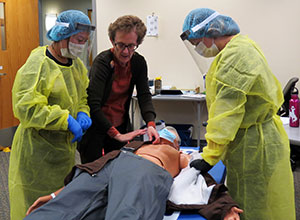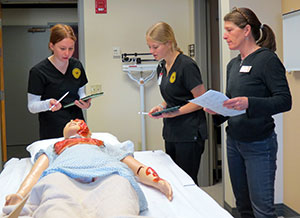
Contact Us
Institutional Communications
Bureau of Mines Building, Room 137
Laramie, WY 82071
Phone: (307) 766-2929
Email: cbaldwin@uwyo.edu
UW Nursing School Adopts Disaster Management Leadership Training
Published February 14, 2024

Sherrill Smith (center), dean of the UW Fay W. Whitney School of Nursing, demonstrates
for students the proper and improper methods of decontaminating a patient who has
been exposed to radiation. Students also received training during this simulation
on the importance of wearing proper personal protective equipment. (UW Photo)
On an increasingly volatile world stage, health care professionals need to prepare themselves and patients for chemical, natural and man-made disasters as well as global pandemics.
In response to the need for such training, the University of Wyoming’s Fay W. Whitney School of Nursing has adopted disaster management leadership training that allows students to experience and respond to staged events -- including treating a burn victim; a person needing to be evacuated from a disaster area, such as an earthquake; and an individual needing decontamination because of radiation exposure.
As part of new competencies in the School of Nursing curriculum, the disaster management leadership training experience recognizes nursing as a health profession supplying the largest number of care providers and a significant part of the global disaster response workforce.
During the first of these trainings, Denise Gable, a certified health care simulation operations specialist with the School of Nursing’s Clinical Simulation Center, used lifelike manikin patients as disaster victims and included realistic settings to help make the trainings seem real.
In all, 30 senior nursing students took part in three separate disaster simulations, dividing into groups and rotating through each simulation.
The first simulation depicted a patient with burns on the chest, face and arms. A flexible rubber overlay of partial thickness burns was used to simulate burned tissue. The students were expected to assess and identify appropriate treatment for the types of burns presented.
In the second simulation, students suited up in protective clothing and treated a patient who had been exposed to radiation. Once all protective clothing was in place, including face shields and protective masks, students took turns removing the patient’s radiation-exposed clothing, removing the contamination with soap and water, and then covering the patient with a clean, sterile sheet.
“The skill of decontamination is crucial during a chemical or radiological disaster for several key reasons,” says nursing student Reese Knapp, from Conifer, Colo. “This includes preventing further exposure; protecting health care workers and vital logistical assets; containing the hazard; and safeguarding the community.”
In the third simulation, office furniture had been turned over and scattered about to appear as if an earthquake, tornado or other disaster had hit the area. The manikin patient appeared disjointed and lying on the floor -- like a person who was injured in such an event. Nursing students then placed the patient on an evacuation sled with ropes attached and experienced what transporting an injured person through rubble and debris involves.

From left, UW nursing students Raegan Finkeldei, from Lawrence, Kan., and Teddi
Jones, from Sundance, along with graduate assistant Tina O’Connor, assess and identify
appropriate treatment for the types of burns presented on a patient. (UW Photo)
“I was pleasantly surprised at how well the equipment worked. I was worried that I would not be able to operate it well, but it turned out to be OK,” says nursing student Adriann Lausen, from Buffalo. “Honestly, practicing with no stress was actually kind of fun. However, I can tell that using equipment like this in a real emergency situation, while stressful, would be extremely helpful. I hope I will never have to use equipment like this, but I am happy I learned how. If I am ever in this situation, I am confident that I would be able to use them.”
Sherrill Smith, dean and professor in the School of Nursing, says the disaster management leadership training is an important part of the students’ learning experience.
“Health care providers must be prepared, often without notice, to respond to a natural or man-made disaster to prevent loss of life or permanent disability,” Smith says. “We are proud to be able to offer our students opportunities to prepare them for the unexpected.”
About the UW College of Health Sciences
UW’s College of Health Sciences trains health and wellness professionals and researchers in a wide variety of disciplines, including medicine, nursing, pharmacy, speech-language pathology, social work, kinesiology, public health, health administration and disability studies. The college also oversees residency and fellowship programs in Casper and Cheyenne, as well as operating a speech/hearing clinic in Laramie and primary care clinics in Laramie, Casper and Cheyenne.
With more than 1,600 undergraduate, graduate and professional students, the college is dedicated to training the health and wellness workforce of Wyoming and conducting high-quality research and community engagement, with a particular focus on rural and frontier populations.
Contact Us
Institutional Communications
Bureau of Mines Building, Room 137
Laramie, WY 82071
Phone: (307) 766-2929
Email: cbaldwin@uwyo.edu
